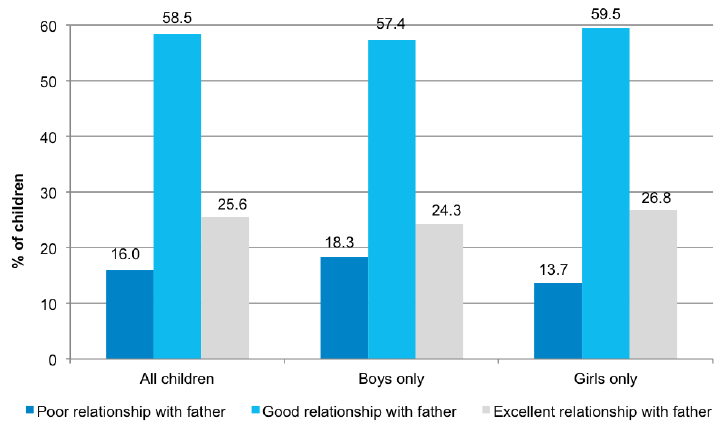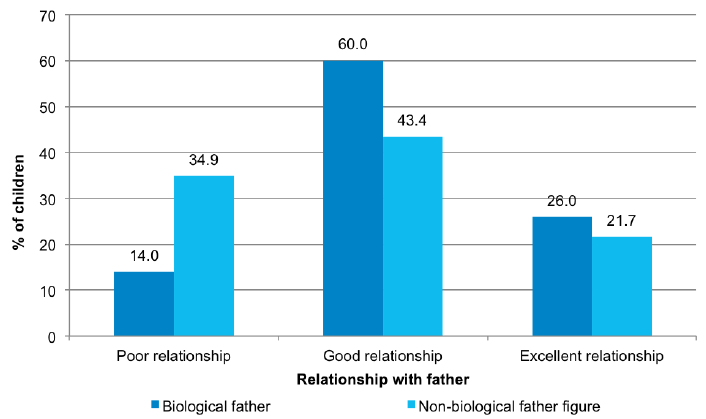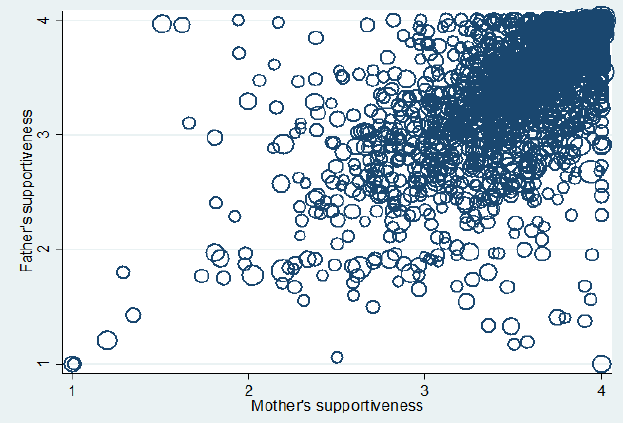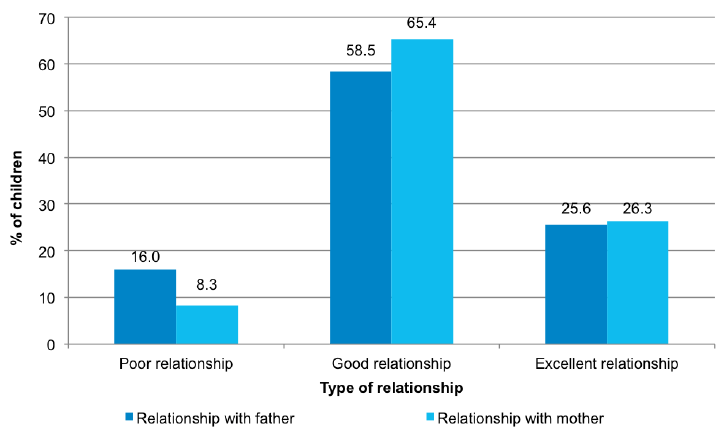Growing Up in Scotland: father-child relationships and child socio-emotional wellbeing
Research report providing insight into the nature of father-child relationships in Scotland.
Chapter 3: Distribution Of Poor, Good And Excellent Father-Child Relationships
3.1 Introduction
This section considers the overall distribution of poor, good and excellent father-child relationships, based on ten year-old children's perceptions of fathers' supportiveness. Boys and girls are examined separately, to see whether fathers' supportiveness varies according to child gender. In addition, father-child relationships for families with a resident biological father are compared to those in families with a non-biological father figure.
The section also investigates the extent to which fathers' supportiveness goes hand-in-hand with mothers' supportiveness. It compares the distribution of father-child and mother-child relationships across the sample. This allows us to look at the totality of parental support for the child, and to see where the child's relationship with one or both parents may need strengthening.
3.2 Key findings
- Most ten year-olds are very positive about their father's supportiveness, with 84% of father-child relationships being classified as "good" or "excellent" in terms of children's perceptions of fathers' supportiveness
- Girls perceive more supportiveness from fathers than boys, although differences were small
- Children with a father figure report lower supportiveness than those with a resident biological father
- The quality of father-child relationships is strongly associated with the quality of mother-child relationships
- Children are just as likely to report excellent relationships with their father as with their mother, but poor father-child relationships are more common (16%) than poor mother-child relationships (8%)
3.3 Distribution of poor, good and excellent father-child relationships
Most ten year-olds in the study sample report high levels of supportiveness from fathers. Overall, 59% of father-child relationships are classified as "good" and 25% as "excellent", leaving 16% that are "poor" in terms of supportiveness. Girls are slightly more positive about their relationship with their father than boys. Among girls, 27% have an excellent relationship with their father, and 14% a poor relationship. The corresponding figures for boys are 24% (excellent) and 18% (poor). This gender difference is statistically significant ( p<0.05), see Figure 3-A. However, this gender difference is not confined to father-child relationships.
As we see later in the report, a similar gender difference was found for mother-child relationships, with boys more likely than girls to have a poor relationship with their mother ( sections 4.6 and 5.3.4).
Figure 3-A Distribution of poor, good and excellent father-child relationships for all children and by child gender

Note: base sample n=2593 (unweighted).
3.4 Comparison of father-child relationships for biological fathers and father figures
Children are more likely to have a poor relationship with a father figure (35%) than with a biological father (14%), see Figure 3-B. However, the proportions of children having an excellent relationship in the two types of family are more similar (26% for biological father, 22% for father figure).
Figure 3-B Father-child relationships according to family type

Note: base samples were families with biological father, n=2411; families with non-biological father n=182 (unweighted).
A similar effect of having a father figure is found for boys and girls. Among boys, 40% of those with a father figure have a poor relationship compared to 16% of those with a biological father. Among girls, 30% have a poor relationship with a father figure compared to 12% of those with a biological father.
In order to investigate whether non-biological resident father figures' supportiveness increases with more time spent in the family, we subdivided families according to whether the father figure had been living in the family prior to the age 10 interview ("established" father figure, n=110) or whether he was recorded as a new household member at this time ("recent" father figure, n=72). We do not have information on when the "recent" father figure entered the household during the two-year period from the age 8 to age 10 interview, and so "recent" could in practice denote up to two years' residence.
Children with established father figures are less likely to have a poor relationship (31%) and more likely to have an excellent relationship (24%) compared to those with recent father figures (where 42% had a poor relationship, and 18% had an excellent relationship).
However, even for established father figures, supportiveness appears lower than for children with a resident biological father.
In addition to time spent living with the family, marriage to the child's mother might be another indicator of the extent to which father figures are embedded in family life. Too few "recent" father figures (as defined above) were married to the mother to allow us to examine the effects of marriage for this group. Among established father figures (i.e. they had lived
in the family for more than two years), around half were married to the mother. Children are less likely to have a poor relationship if their established father figure is married to the mother (25% did so, compared to 39% when the established father figure is not married to the mother). Further, children with a married established father figure are more likely to have an excellent relationship (30%, compared to 16% with an unmarried established father figure). Parental marital status in considered in more detail in section 4.4.
3.5 Distribution of father-child and mother-child relationships
The quality of children's relationship with the father tends to go hand-in-hand with their relationship with the mother. This was examined using a measure of correlation. Scores for this measure range from where 0 (no correlation) to 1 (perfect correlation). Average relationship supportiveness scores for each parent show a strong positive correlation (Pearson correlation coefficient, r=0.68, p<0.001). This correlation is still strong among families with a father figure (r=0.57, p<0.001). Among children from all couple families, most (70%) children who have an excellent relationship with their mother also have an excellent relationship with their father. Similarly, two-thirds of children (66%) who have a poor relationship with the mother also have a poor relationship with their father.
The strong association between the quality of the child's relationship with each parent is also illustrated by Figure 3-C, which plots average supportiveness in father-child relationships according to average supportiveness in mother-child relationships. This Figure does, however, also show that there were some children who had a good or excellent relationship with one parent (scoring 3 or more on the supportiveness scale), but a poor relationship with the other parent (scoring under 3 on supportiveness).
Figure 3-C Association between average scores for child's relationship with father and mother

Note: Base sample n=2593 (unweighted). Circle size reflects survey weighting, with larger circles reflecting a higher survey weight.
Average relationship supportiveness scores are slightly lower for father-child relationships than for mother-child relationships [4] . Children are just as likely to have an excellent relationship with their father as with their mother (26% for both parents). However, there are twice as many children with a poor relationship with their father (16%) as there are children with a poor relationship with their mother (8%). See Figure 3-D.
Similar differences are observed for boys and girls [5] . Among boys, 10% have a poor relationship with their mother, compared to 18% with their father. Among girls, 7% have a poor relationship with their mother, compared to 14% with their father.
Figure 3-D Comparison of father- and mother-child relationships

Note: base sample n=2593 (unweighted).
The quality of children's relationship with their mother does not differ according to whether a family contained both biological parents or contained a non-biological father figure. The gap between children's perceptions of mothers' and fathers' supportiveness is therefore wider for families with a non-biological father than for families with both biological parents. Among families with a non-biological father, 8% of children have a poor relationship with the mother, compared to 35% with the non-biological resident father figure (Figure 3-E).
Figure 3-E Comparison of father-and mother-child relationships in families with a non-biological resident father figure

Note: base sample of families with non-biological residential father figure n=182 (unweighted).
We categorised children in couple families according to their relationship with both parents. A third of children (33%) have an excellent relationship with at least one parent, and 18% have an excellent relationship with both their parents. The great majority of children in the sample (95%) have a good or excellent relationship with at least one parent. Although this means that only 5% have a poor relationship with both parents, an additional 15% have a poor relationship with one parent. This is more likely to be a poor relationship with the father (11%) than a poor relationship with the mother (3%).
Contact
Email: Wendy van der Neut
There is a problem
Thanks for your feedback